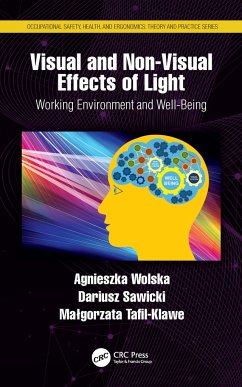Agnieszka Wolska, Dariusz Sawicki, Malgorzata Tafil-Klawe
Visual and Non-Visual Effects of Light
Working Environment and Well-Being
Agnieszka Wolska, Dariusz Sawicki, Malgorzata Tafil-Klawe
Visual and Non-Visual Effects of Light
Working Environment and Well-Being
- Gebundenes Buch
- Merkliste
- Auf die Merkliste
- Bewerten Bewerten
- Teilen
- Produkt teilen
- Produkterinnerung
- Produkterinnerung
The publication will present the impact of light in the working environment on human well-being and health. It will define the consequences of inadequate lighting on visual comfort, eye strain and shifts in the circadian cycle and their consequences for safety and health.
Andere Kunden interessierten sich auch für
![Learning and Relearning Equipment Complexity Learning and Relearning Equipment Complexity]() Sasho AndonovLearning and Relearning Equipment Complexity134,99 €
Sasho AndonovLearning and Relearning Equipment Complexity134,99 €![Biosafety and Biosecurity Biosafety and Biosecurity]() Biosafety and Biosecurity135,99 €
Biosafety and Biosecurity135,99 €![Canine Ergonomics Canine Ergonomics]() Canine Ergonomics145,99 €
Canine Ergonomics145,99 €![Danish Design Heritage and Global Sustainability Danish Design Heritage and Global Sustainability]() Ditte Lysgaard VindDanish Design Heritage and Global Sustainability172,99 €
Ditte Lysgaard VindDanish Design Heritage and Global Sustainability172,99 €![Just Culture and the Criminalisation of Air Accidents Just Culture and the Criminalisation of Air Accidents]() Simon DanielsJust Culture and the Criminalisation of Air Accidents131,99 €
Simon DanielsJust Culture and the Criminalisation of Air Accidents131,99 €![Experiential Learning in Engineering Education Experiential Learning in Engineering Education]() Alan L SteeleExperiential Learning in Engineering Education158,99 €
Alan L SteeleExperiential Learning in Engineering Education158,99 €![Positive Psychology and Biodiversity Conservation Positive Psychology and Biodiversity Conservation]() Jolanta BurkePositive Psychology and Biodiversity Conservation172,99 €
Jolanta BurkePositive Psychology and Biodiversity Conservation172,99 €-
-
-
The publication will present the impact of light in the working environment on human well-being and health. It will define the consequences of inadequate lighting on visual comfort, eye strain and shifts in the circadian cycle and their consequences for safety and health.
Produktdetails
- Produktdetails
- Verlag: CRC Press
- Seitenzahl: 202
- Erscheinungstermin: 29. Juli 2020
- Englisch
- Abmessung: 234mm x 156mm x 14mm
- Gewicht: 490g
- ISBN-13: 9780367444198
- ISBN-10: 0367444194
- Artikelnr.: 59927090
- Herstellerkennzeichnung
- Libri GmbH
- Europaallee 1
- 36244 Bad Hersfeld
- gpsr@libri.de
- Verlag: CRC Press
- Seitenzahl: 202
- Erscheinungstermin: 29. Juli 2020
- Englisch
- Abmessung: 234mm x 156mm x 14mm
- Gewicht: 490g
- ISBN-13: 9780367444198
- ISBN-10: 0367444194
- Artikelnr.: 59927090
- Herstellerkennzeichnung
- Libri GmbH
- Europaallee 1
- 36244 Bad Hersfeld
- gpsr@libri.de
Agnieszka Wolska, PhD (Eng), DSc, Head of Optical Radiation Laboratory in the Central Institute for Labour Protection - National Research Institute. She was graduated from the Faculty of Electrical Engineering (specialization: Lighting Engineering) at the Warsaw University of Technology (Poland). In 1997 she prepared her dissertation (Ph.D.): "Environmental luminance in the visual field of VDT operators and visual fatigue" and in 2014 she prepared her D.Sc. monograph "Optical radiation in the working environment", both at Technical University of Biäystok. She carries out activities in the area of lighting engineering, influence of lighting on psychophysiology of vision (experimental studies concerning evaluation of visual fatigue, visual comfort, psychomotor performance and alertness related to lighting of different parameters), visual ergonomics, hazards of optical radiation, risk assessment at the work stands. She is an expert of Group for Physical Agents (optical radiation) of Polish Interdepartmental Commission for MAC and MAI Values (from 2009). She is also a member of CIE Division 1 (Vision and colour), Polish Ergonomics Society, Polish Committee on Illumination, European experts' network of occupational safety and health EUROSHNET. Dariusz Sawicki, PhD (Eng), DSc, Head of Department of Information-Measuring Systems in Warsaw University of Technology. He was graduated from the Faculty of Electrical Engineering (specialization: Metrology) at the Warsaw University of Technology (Poland). In 1987 he prepared his dissertation (Ph.D.): "Komputerowa metoda graficznego przedstawiania powierzchni opisanych równaniami parametrycznymi" and in 2008 he prepared his D.Sc. monograph "Wybrane problemy symulacji figury jasnych punktów z wykorzystaniem metody ¿ledzenia promieni", both at Warsaw University of Technology. He carries out activities in the area of computer graphics, ray tracing, global illumination, ray tracing application in lighting technology, human visual system and color perception, human computer interaction, lighting measurement, especially glare. He is a member of CIE Division 8 (Image technology), IEEE (Computer Society), Senior Member of Association for Computing Machinery (ACM) and Polish Society of Informatics. Mägorzata Tafil-Klawe, PhD, D.Med.Sc., Head of Human Physiology Department of Ludwik Rydygier Collegium Medicum in Bydgoszcz of Nicolaus Copernicus University in Toru¿ (Poland). She was graduated from the faculty of Medicine (specialization Human Physiolgy) at the Medical University in Warsaw, Poland. In 1982 she prepared her dissertation (Ph.D. med. Sc.) and in 1991 she prepared her D.Sc med. Sc at Medical University University of Warsaw. She got the scientific title of Professor in 2006. She carries out activities in the area of: human physiology, chronobiology with elements of chronomedicine, sleep physiology, cardiovascular regulation, respiratory medicine.
1. Introduction. 2. Vision Physiology. 3. Working Environment and Workers Well
Being. 4. Light
Visual Impact on Human Well
Being. 5. Lighting Design to Ensure the Convenience of Vision. 6. Light
Extracorporeal Impact on Human Well
Being. 7. Effects of Light on Human Well
Being. 8. Lighting Design with Consideration of Circadial Stimulator. 9. Light Pollution Problem. 10. Summary.
Being. 4. Light
Visual Impact on Human Well
Being. 5. Lighting Design to Ensure the Convenience of Vision. 6. Light
Extracorporeal Impact on Human Well
Being. 7. Effects of Light on Human Well
Being. 8. Lighting Design with Consideration of Circadial Stimulator. 9. Light Pollution Problem. 10. Summary.
1. Introduction. 2. Vision Physiology. 3. Working Environment and Workers Well
Being. 4. Light
Visual Impact on Human Well
Being. 5. Lighting Design to Ensure the Convenience of Vision. 6. Light
Extracorporeal Impact on Human Well
Being. 7. Effects of Light on Human Well
Being. 8. Lighting Design with Consideration of Circadial Stimulator. 9. Light Pollution Problem. 10. Summary.
Being. 4. Light
Visual Impact on Human Well
Being. 5. Lighting Design to Ensure the Convenience of Vision. 6. Light
Extracorporeal Impact on Human Well
Being. 7. Effects of Light on Human Well
Being. 8. Lighting Design with Consideration of Circadial Stimulator. 9. Light Pollution Problem. 10. Summary.









